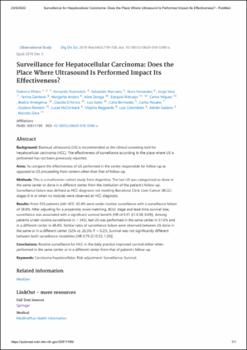| dc.contributor.author | Piñero, Federico. | |
| dc.contributor.author | Rubinstein, Fernando. | |
| dc.contributor.author | Marciano, Sebastián. | |
| dc.contributor.author | Fernández, Nora. | |
| dc.contributor.author | Silva, Jorge. | |
| dc.contributor.author | Zambelo, Yanina. | |
| dc.contributor.author | Anders, Margarita. | |
| dc.contributor.author | et al. | |
| dc.date.accessioned | 2020-09-23T21:20:36Z | |
| dc.date.available | 2020-09-23T21:20:36Z | |
| dc.date.issued | 2019-03-01 | |
| dc.identifier.citation | Dig Dis Sci . 2019 Mar;64(3):718-728. | en_US |
| dc.identifier.issn | 1573-2568 | |
| dc.identifier.uri | https://riu.austral.edu.ar/handle/123456789/958 | |
| dc.description.abstract | Abstract
Background: Biannual ultrasound (US) is recommended as the clinical screening tool for hepatocellular carcinoma (HCC). The effectiveness of surveillance according to the place where US is performed has not been previously reported.
Aims: To compare the effectiveness of US performed in the center responsible for follow-up as opposed to US proceeding from centers other than that of follow-up.
Methods: This is a multicenter cohort study from Argentina. The last US was categorized as done in the same center or done in a different center from the institution of the patient's follow-up. Surveillance failure was defined as HCC diagnosis not meeting Barcelona Clinic Liver Cancer (BCLC) stages 0-A or when no nodules were observed at HCC diagnosis.
Results: From 533 patients with HCC, 62.4% were under routine surveillance with a surveillance failure of 38.8%. After adjusting for a propensity score matching, BCLC stage and lead-time survival bias, surveillance was associated with a significant survival benefit [HR of 0.51 (CI 0.38; 0.69)]. Among patients under routine surveillance (n = 345), last US was performed in the same center in 51.6% and in a different center in 48.4%. Similar rates of surveillance failure were observed between US done in the same or in a different center (32% vs. 26.3%; P = 0.25). Survival was not significantly different between both surveillance modalities [HR 0.79 (CI 0.53; 1.20)].
Conclusions: Routine surveillance for HCC in the daily practice improved survival either when performed in the same center or in a different center from that of patient's follow-up. | en_US |
| dc.language.iso | en | en_US |
| dc.publisher | Springer Science+Business Media, LLC, part of Springer Nature | en_US |
| dc.subject | Carcinoma hepatocellular | en_US |
| dc.subject | Risk adjustment | en_US |
| dc.subject | Surveillance | en_US |
| dc.subject | Survival | en_US |
| dc.title | Surveillance for Hepatocellular Carcinoma: Does the Place Where Ultrasound Is Performed Impact Its Effectiveness? | en_US |
| dc.type | Article | en_US |


